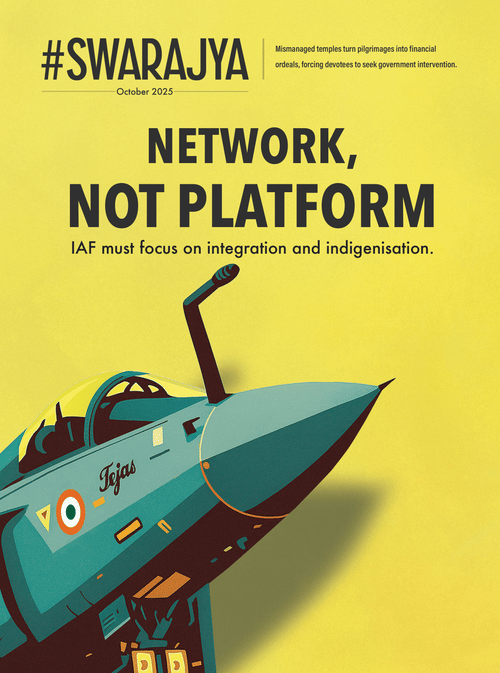Science
Quantum Phoenix: How Destructive Noise Can Bring Entanglement Back From Death
Aravindan Neelakandan
Oct 22, 2025, 07:30 AM | Updated Oct 21, 2025, 10:44 PM IST
Save & read from anywhere!
Bookmark stories for easy access on any device or the Swarajya app.
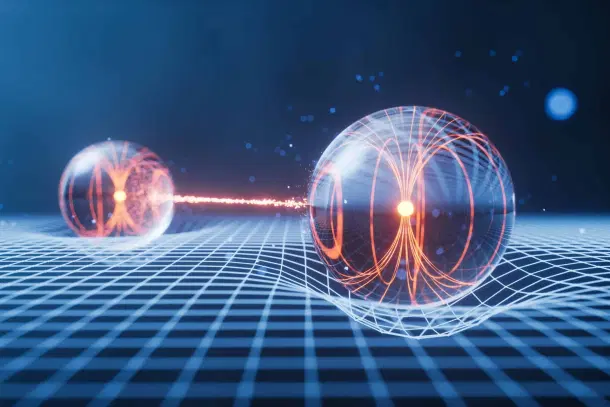
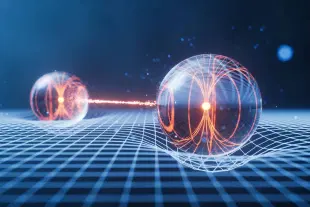
The future, as envisioned by quantum physicists, is a place of breath-taking possibility. It is a world powered by computers that can solve problems currently beyond our reach, from designing life-saving drugs to unravelling cosmic mysteries.
The primary antagonist in this story, the force that threatens to shatter the quantum dream, is a phenomenon known as decoherence.
In the pristine realm of theory, quantum states exist in a superposition of multiple possibilities at once. But any interaction with the outside world — a stray photon, a tiny vibration, a fluctuation in a magnetic field — acts like a clumsy observation, forcing the quantum system to choose a single classical state. This constant environmental chatter is the quantum noise that corrupts fragile quantum information, erasing the very properties that make it so powerful.
At the core of this fragile world lies its most precious and enigmatic resource: quantum entanglement. At its heart is a mysterious link that binds particles across space. It is a strange phenomenon Einstein once famously called spooky action at a distance. Once entangled, particles behave as a single entity, no matter how far apart they are. Measuring one instantaneously influences the other. This quantum heartbeat is the magic ingredient for teleportation, supercharged computation, and secure communication. Protecting this resource from the relentless onslaught of environmental noise is arguably the single most critical challenge facing quantum engineers today.
For decades, the narrative has been simple: noise is the enemy, and entanglement is its victim. Traditionally, quantum noise has been seen as the enemy of entangled systems, causing them to lose their spooky connection through decoherence. But what if this long-standing assumption was wrong?
A ground-breaking study from Indian scientists at the Raman Research Institute (RRI) and their collaborators challenges this quantum dogma, turning the simple hero-villain story on its head.
Their work reveals a shocking paradox: for a certain type of entanglement, the villain of noise can sometimes play a stunningly constructive role. It can resurrect entanglement after it has been completely destroyed and even create it where none existed before. This discovery does not just offer a new defence against decoherence; it suggests a radically new path toward building robust quantum machines, one that works with the environment rather than fighting a losing battle against it.
Entanglement: The Classic Twins vs. The Hybrid Being
To grasp the revolutionary nature of this finding, one must first understand that entanglement is not a monolith. It comes in at least two distinct forms, and this distinction is the key to the entire story.
Interparticle Entanglement (The Classic Twins)
This is the form of entanglement that has captured the public imagination. It involves a quantum correlation between two or more spatially separated particles. The classic analogy is a pair of perfectly correlated coins. If you entangle them and send one to a friend on the other side of the galaxy, the moment you flip your coin and see “heads”, you know with absolute certainty that your friend’s coin, at that exact instant, has landed on “tails”. This perfect, instantaneous correlation, independent of distance, is the spooky action that so troubled Einstein.
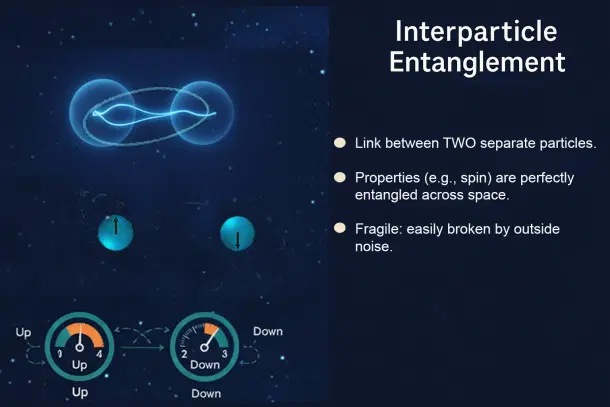
Most of the world’s current efforts in building quantum computers, whether using trapped ions or superconducting circuits, are focused on creating and preserving these intricate links between separate particles. This is the conventional case, the established benchmark.
Intraparticle Entanglement (The Hybrid Being)
The second, less intuitive form of entanglement is central to this new research: intraparticle entanglement. This is a quantum correlation not between different particles, but between different properties within a single particle.
Imagine a single, magical subatomic particle with two independent properties, such as its direction of spin (up or down) and its path through an experiment (left or right). Intraparticle entanglement means these two properties are inextricably linked. If you measure the particle’s spin and find it is “up”, you instantly know it must have taken the “left” path, and vice versa.
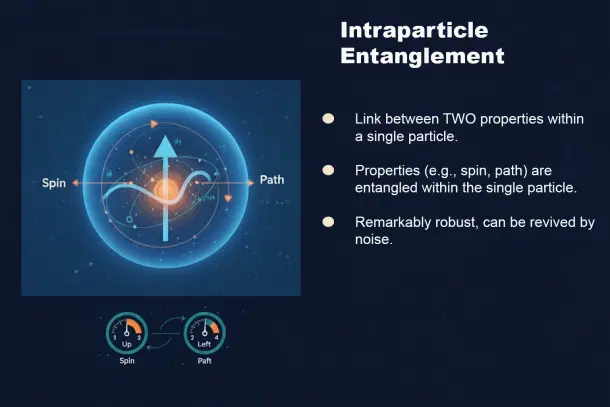
The particle’s internal characteristics are entangled with each other, creating a complex, hybrid quantum entity. This is not just a mathematical theory; it has been verified in systems like neutrons and photons, and since the results are not dependent on any particular physical setup, they would be stable across various platforms.
The Blindspot
While physicists have known about intraparticle entanglement for years, its behaviour in noisy, real-world environments has remained a significant theoretical blind spot. The new research illuminates this gap by revealing that the crucial difference between the two types of entanglement is not just about the location of the properties (“between particles” versus “within a particle”), but about how the surrounding environment physically interacts with the system.
Let us first consider interparticle entanglement (local interaction). When two separate particles are entangled, the environment treats them as two distinct two-level systems, known as qubits. Noise tends to act on each of these particles locally and independently.
In contrast, for intraparticle entanglement (global interaction), a single particle with two entangled internal properties behaves as a single, unified, and more complex four-level system — a qudit. The environment does not see two separate parts to affect; it sees only one target and acts on it globally.
This fundamental structural difference — whether the environment interacts with two separate qubits locally or with one unified qudit globally — is the very seed of the wildly divergent behaviours the scientists observed when both systems were subjected to noise.
Modelling Quantum Noise
Physicists model environmental interactions as structured processes called noisy channels, each with its own distinct character. The RRI-led team explored the impact of three common types of quantum noise on these intraparticle systems, simulating different kinds of environmental disturbances.
Amplitude Damping: This channel, which produced the most startling results, represents a process of energy dissipation or loss. An intuitive analogy is the sound of a plucked guitar string fading away as its energy dissipates. This channel causes the system to decay toward a lower energy state.
Phase Damping: This type of noise attacks a system’s coherence without causing energy loss. It scrambles the delicate phase relationships between quantum states. This is a common form of decoherence that degrades the quantumness of a system. Imagine a flock of birds flying in a perfect V-formation. Over time, they slowly fall out of sync and the precise formation is lost. Each bird still has its own energy to fly, but the coherent, collective pattern has disappeared.
Depolarising Noise: This is a more brute-force and chaotic form of noise that essentially scrambles quantum information. Unlike other, more structured types of noise, its effect is to completely randomise the state. With a certain probability, it erases the original quantum state and replaces it with a totally random, mixed one.
A Quantum Phoenix from the Ashes of Entanglement Death
Raman Research Institute scientists, using a precise mathematical formula to track entanglement, took a single particle with entangled internal properties and passed it through the amplitude-damping channel. They then steadily turned up the noise dial, calculating the amount of entanglement using a rigorous metric known as concurrence, which ranges from 0 (no entanglement) to 1 (maximum entanglement).
The expected outcome was simple: as noise increases, entanglement should steadily decrease to zero and stay there. What they observed was anything but standard.
The entanglement started high, and as the noise began, it plummeted, just as expected. It quickly hit exactly zero, an event physicists call Entanglement Sudden Death (ESD). At this point, all quantum correlation was gone.
But then, the paradox occurred.
As the noise parameter continued to increase past the point of death, the entanglement miraculously sprang back to life. The concurrence rose from the ashes of zero, climbed to a new peak, and only then began its final decay as the noise approached maximum. This is the rebirth of entanglement — a quantum phoenix rising from the noise that was supposed to be its destroyer.
Quantum Ex Nihilo
But the story gets even stranger. The researchers started with a particle whose internal properties were completely independent — a state with zero entanglement. They then began to turn on the noise. In a direct violation of all classical intuition, the introduction of this destructive environmental interaction created entanglement out of nothing. The concurrence rose from zero to a significant peak before eventually decaying.
The paradoxical revival is the most spectacular finding, but the study’s broader conclusion is perhaps even more significant for practical technology: intraparticle entanglement is simply tougher than its interparticle counterpart across the board.
A head-to-head comparison is compelling.
When identical initial states were subjected to the same noise, the results were starkly different. The decay of quantum properties in the interparticle case was much greater for the same noise strength. Crucially, this superior resilience of intraparticle entanglement is not limited to the amplitude-damping channel; the finding holds true for phase damping and depolarising channels as well. No matter the type of noise, the internal, unified nature of intraparticle entanglement provides an inherent protection that separated particles lack.
Implications for Future Technology
These findings force a profound re-evaluation of noise. This represents a paradigm shift from a philosophy of isolation to one of potential symbiosis.
The interaction with the noise channels is not merely passive erasure; it is an active, dynamic process that can reconfigure a quantum state. It elevates noise from a mere nuisance to be eliminated to a potential parameter that could be co-opted and even engineered. It suggests a future where, instead of building perfect shields, scientists might design controlled interactions with an engineered environment to actively generate or restore the very entanglement needed.
Quantum physicist Prof. Dipankar Home of Bose Institute, Kolkata, points out that the work using intraparticle entanglement “opens up uncharted avenues for user-friendly, commercially viable, cutting-edge quantum technological applications in the presence of various models of noise or damping.”
This research at Raman Research Institute is conducted under the India-Trento Programme on Advanced Research (ITPAR) and partially supported by the National Quantum Mission (NQM) of DST.
Journal reference: Intraparticle entanglement in noisy quantum channels: degradation and revival through amplitude damping
